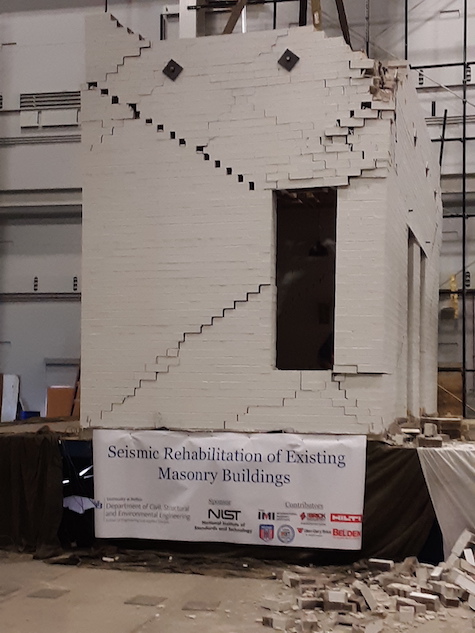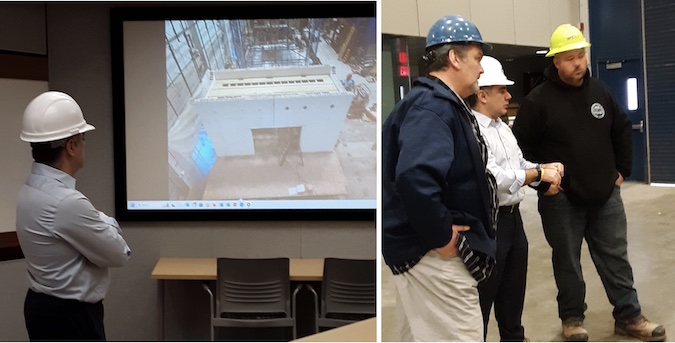UB seismic study, using structure built by Job Corps students, shows unexpected damage in earthquake simulation
‘What we know so far is very eye opening. It can change the building code.’
BUFFALO – Researchers at the University of Buffalo have been working for almost four years on a project to improve the seismic performance and resilience of unreinforced masonry buildings. During the past year they have received help from masonry students at the Iroquois Job Corps in Medina for construction of the test structures, one of which is the largest ever tested on a shake table.
The project is funded by the National Institute of Standards and Technology and has also received donations and contributions from HILTI, the International Masonry Institute, Iroquois Job Corps, the Brick Industry Association, the Belden Brick Company and Glen-Gery Corporation.

This structure, built with help from Iroquois Job Corps’ masonry students, was tested for a week at the University at Buffalo’s structural and earthquake simulation lab. The last test damaged the structure beyond repair. Professor Andreas Stavridis, the Principal Investigator of the project, said he didn’t expect to see this amount of damage.
On Friday morning, Iroquois Job Corps masonry instructors Lino Cometto and Robert Kelichner and two Job Corps students traveled to the University at Buffalo’s Ketter Hall, expecting to witness a shake table test of a building they had helped apprentices and researchers construct. This would have been the sixth day of seismic tests on the building.
Upon arriving at Ketter Hall, the instructors and students learned from Professor Andreas Stavridis, the Principal Investigator of the project, that the strengthened masonry building sustained considerable damage during a test they decided to do on Thursday, feeling confident it would not sustain damage.
Stavridis explained the building was reinforced with five steel members placed in strategic locations, as well as steel plates and anchors.
“If it wasn’t for those steel members, the building would have collapsed,” Stavridis said. “They did well, but we have to do better. I was very surprised at what happened. “We had done two other tests and didn’t find a crack. This test, however, was 20 percent stronger. Now we need to study the data we have from the 170 sensors on the building. Once we understand what happened, we will investigate ways to improve the behavior. Then, we will build and test another one next year.”
It took the apprentice bricklayers and Job Corps students a week and a half to build the masonry structure. Then the researchers build a roof, and installed the steel members for the seismic upgrade. They also installed a large array of sensors. They started testing the structure in week 9 and, they are into their 10th week in the lab, Stavridis said.
Stavridis said UB’s seismic lab was the only one of its kind in the US able to conduct this test when he wrote the proposal to NIST.
He discussed the importance of strengthening masonry structures to withstand severe earthquakes, such as the recent one in Turkey.
“There are more than eight million buildings of unreinforced masonry buildings in the country,” he said. “Two years ago, one came down in Buffalo.”
“Some are more than 100 years old,” Cometto said.
After examining the damaged brick structure, the Job Corps masonry instructors and students, along with several others interested observers were able to watch a video of Thursday’s tests.
In the initial tests, nothing happened, but in the last shake, large cracks began to appear, until finally a whole corner came down from the front. The researchers stopped the earthquake half way through to prevent the collapse of the entire structure, which would be catastrophic for the laboratory equipment.
“What we know so far is very eye opening. It can change the building code,” Stavridis said. “This was a very unique test and we have a lot of work to do analyzing the data we got. We will also build computer models to help us understand what factors contributed to what happened.”
“We won’t know for sure for a couple of months,” he said. “When we do, we will build another.”






































































